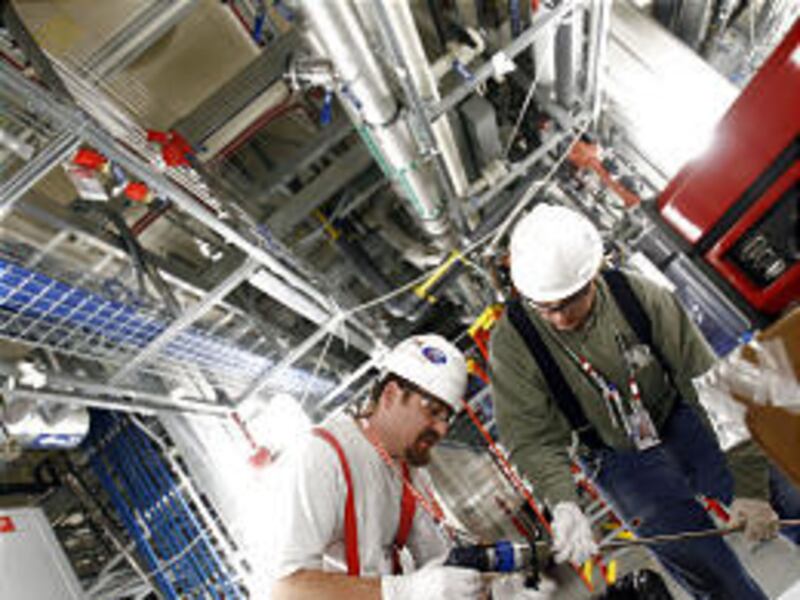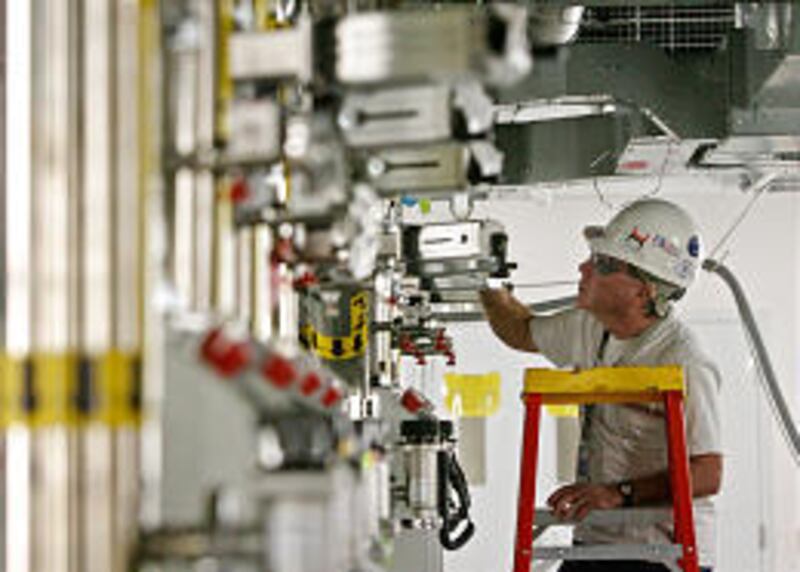LEHI — The "Death Star" is teeming with life.
So-called by employees for years because of its huge, dark and foreboding rooms, tunnels and hallways that lay mostly empty, the buildings that are home to IM Flash Technologies now are a bustling hive of engineers, production employees, contractors and others working on a scale unprecedented in the state's history.
That activity is in stark contrast to what for years served as a massive monument to the foibles of the marketplace. Started in the late 1990s for Micron Technology to produce computer chips, the seven-building Lehi complex saw construction halted when the chip market sank. Dreams of the $1.3 billion plant employing about 3,500 people — which Micron said in 1995 it someday would — instead morphed into 2.3 million square feet of dormancy. Micron was able to move some chip-testing operations there, but, at tops, it had only 500 workers — nothing to sneeze at, but far short of those initial projections.
Already working to produce NAND flash memory, IM Flash is, to a major degree, finally fulfilling the giant structure's promise. About 3,000 contractors are toiling to complete the build-out of 60 percent of the complex's total space, about 1,200 employees of what will be nearly 2,000, have been hired, and the company is halfway through an initial $2 billion, two-year capital investment.
While implementing cold, hard precision technology to process products with subatomic characteristics, IM Flash already has spawned some amazing intangibles statewide: pride, relief and excitement among Utahns at various levels with its embodiment of the power of hope, faith and persistence.
"From my vantage point, this could be the single largest positive development for the state's economy as we move into the future as we've seen in some time," said David Simmons, chairman of the Governor's Office of Economic Development Board, which a year ago approved a tax-rebate incentive that could reach $15 million to lure the IM Flash operations.
"It's exciting to see. I'm not aware of another project done in the state of Utah that has the size and consequence that this has, at least during this last decade. In many ways, it's (the) equivalent of what it must have been to have Geneva Steel built."
Richard Nelson, president and chief executive officer of the Utah Technology Council, recalled attending the facility's groundbreaking and the "great hope" of high-end technology jobs. "Finally," he said, "this is a case of building it, and they eventually will come."
An inside look
It's all happened in a relative flash, as it were, since IM Flash was formed just a little more than a year ago as a joint venture between Intel and Micron. The companies at that time named Lehi as the IM Flash corporate headquarters.
Although the final products are miniscule, the facility's interior space is colossal. Just the huge "spine," a connecting hallway running the length of the buildings and big enough for a semitrailer truck to drive through with ease, would dwarf most of the state's manufacturing facilities.
Contrasts abound. Engineers work in conference rooms or a whisper-quiet room of 400 cubicles, while other parts of the building are a cacophony of construction. Some parts of the huge buildings remain, for now, exposed concrete, gravel, dirt and steel, while other portions shine with fresh paint and carpeting. Gleaming-white hallways indicate clean-room areas, but construction workers, clad in protective gear to keep all sorts of human and construction "debris" from contaminating fabrication operations, labor nearby. Millions of dollars in equipment, thousands of workers, miles of hallways hopping with people, and yet a speck of dust is Enemy No. 1.
"They're building out the site and building a fab, and we've also already started production," IM Flash spokeswoman Laurie Bott said. "We have all three of those functions happening at the same time."
"This project has been one of the most aggressive, where we've overlapped the construction process with the attempt to begin the production process," said Scott McLain, in charge of construction.
Construction is expected to continue for about another year. About 60 sophisticated tools are being added each month, each costing between $1 million and $28 million and about $300,000 just to install.
Coming out
The tools and employees are busy producing 12-inch wafers, each containing about 300 fingernail-size die (lay people would call them "chips") of NAND flash memory that will be used in consumer electronics, removable storage and handheld communication devices such as mobile handsets, digital audio players, digital cameras and GPS navigation devices.
Around-the-clock shifts will eventually churn out up to 2,000 wafers per day. The company expects to have a ceremony this week to mark the first wafer out of the plant. All products will go to Micron and Intel to market, although Apple worked out a deal to get $500 million of inventory.
Lehi is one of only two plants in the country, the other being in Virginia, producing NAND flash.
"This plant is being developed to compete on a global scale with Samsung and Toshiba, as well as other competitors," Bott said. "And NAND flash is going to affect anyone who has an iPod, a security system, digital camera, video camera or car computer because of no moving parts, portable power and memory."
But processing NAND flash is no simple task. Each wafer goes through 400 to 500 processing steps, sometimes going through one of the high-tech tools up to 100 times. The steps can take as little as 10 minutes or up to six hours.
"You want to reduce the entire process to within 30 days," said Todd Mathews, in charge of fabrication. "That's the name of the game, to do it as fast as you possibly can, while also reacting to process shifts and changes."
Early next year, Mathews said, the company will be able to produce 3.4 million die each week. Workers put down layers of materials and components on each die, each having about 64 access points.
"You need an electron microscope," Mathews said, to see details on the die. "You're dealing with things on a subatomic level, so it's really pretty fascinating."
Delayed exuberance
Observers keeping an eye on the long-empty facility year after year likely would not have described that process as "fascinating." But they're armed with lots of adjectives now.
"It's taken many more years than we initially anticipated, and it's for a slightly different purpose than originally planned, and with a joint venture instead of Micron doing it alone," Simmons said. "But what a wonderful, amazing development it is, with an enormous impact in so many ways, from direct employment to all the industry benefits associated with a plant of this kind and the kind of skilled positions that are needed."
IM Flash is "a fantastic success story that is just now starting to unfold," Nelson said.
"Hiring 2,000 employees in such a short period of time is unheard of in the state, especially with high-paying jobs and a good percentage being engineers," he said. "This is an ideal use for the billion-dollar facility they built many years ago. And it's clearly a long-term commitment to Utah."
But Simmons acknowledges that in the past he wondered if today's activities would ever materialize.
"I think everyone had doubts. As was the case with so many developments in the high-tech industry, you live or die by what is happening in the market, and the market changes so rapidly that you're forced to make decisions that have substantial financial impact and may end up later quite different from what you planned," he said.
"Yeah, no question, there was a lot of doubt in a lot of folks' minds as to what would become of this facility, recognizing that Micron had made a substantial investment but at the same time that market conditions were such that they may never find a way to get a return on what had initially been put into the ground."
Those market changes are hitting Micron again, as Mike Sadler, the company's head of sales, told analysts earlier this month that a collapse in the price of NAND chips due to an industry glut has created a "horrible situation" for the company.
But Micron is still moving forward with its Lehi plans, and those involved in the project remain optimistic.
Stan Lockhart, now government affairs manager for IM Flash, served in a similar role for Micron and was the information point man for journalists, politicos and others inquiring about the plant's status and future. Constantly reminding people that Micron had 500 people working at the facility, he now says it's "easier" to discuss the current ratcheting-up of employment and production.
"It's a great day, not only for IM Flash but for the state of Utah," he said. "We've been working on this now for close to 12 years, and it has become, for me, ... just a matter of having faith and having faith in the ability of Micron and now IM Flash to do what they wanted to do from the very beginning. Because market conditions are so important to the ability of a company to expand, you know, we just had to rely on faith.
"There have been upturns and downturns, and through it all, we've just done the very best we could to create an environment in the state of Utah to allow us to be competitive once we got this facility up and running."
Fulfilling its promise
Available parking spaces near the buildings are scarce, where once there was a sea of emptiness. Construction and chatter echo down hallways. Prospective employees keep filing in, hoping to get a part of the $1.1 billion in salaries the company is expecting to pay over the next decade. Mathews revels in the qualifications of his workers, saying IM Flash has "found a gold vein of technologists."
So different from the scene not so long ago. Mathews recalled that even when chip-testing peaked, it used only 65,000 square feet of space and only one-eighth of the parking area — so open that workers had plenty of room to put up a basketball hoop for pickup games.
"The feeling was difficult from the sense that everything around them was a daily reminder of 'we're not going anywhere, and we're not doing anything,'" he said. "It was all a daily reminder that the potential was always here and that it wasn't coming. From their perspective, they're all extremely excited and so motivated to see this all coming to fruition and see that potential being realized."
For Lockhart, it was a matter of sticking with the vision of what the Lehi facility could be: a base of cutting-edge technology and innovation, a huge capital investment, potential jobs for his children and eventually his grandchildren "and everybody else's in Utah."
"It's been a love affair, and while there have been times when I have been less optimistic than other times, I always had a conviction deep in my heart that Micron, and now IM Flash, would be good for the state and good for Utah County and good for Lehi," he said.
"I think it has been up to now and think it will be for a long time to come."
E-mail: bwallace@desnews.com





